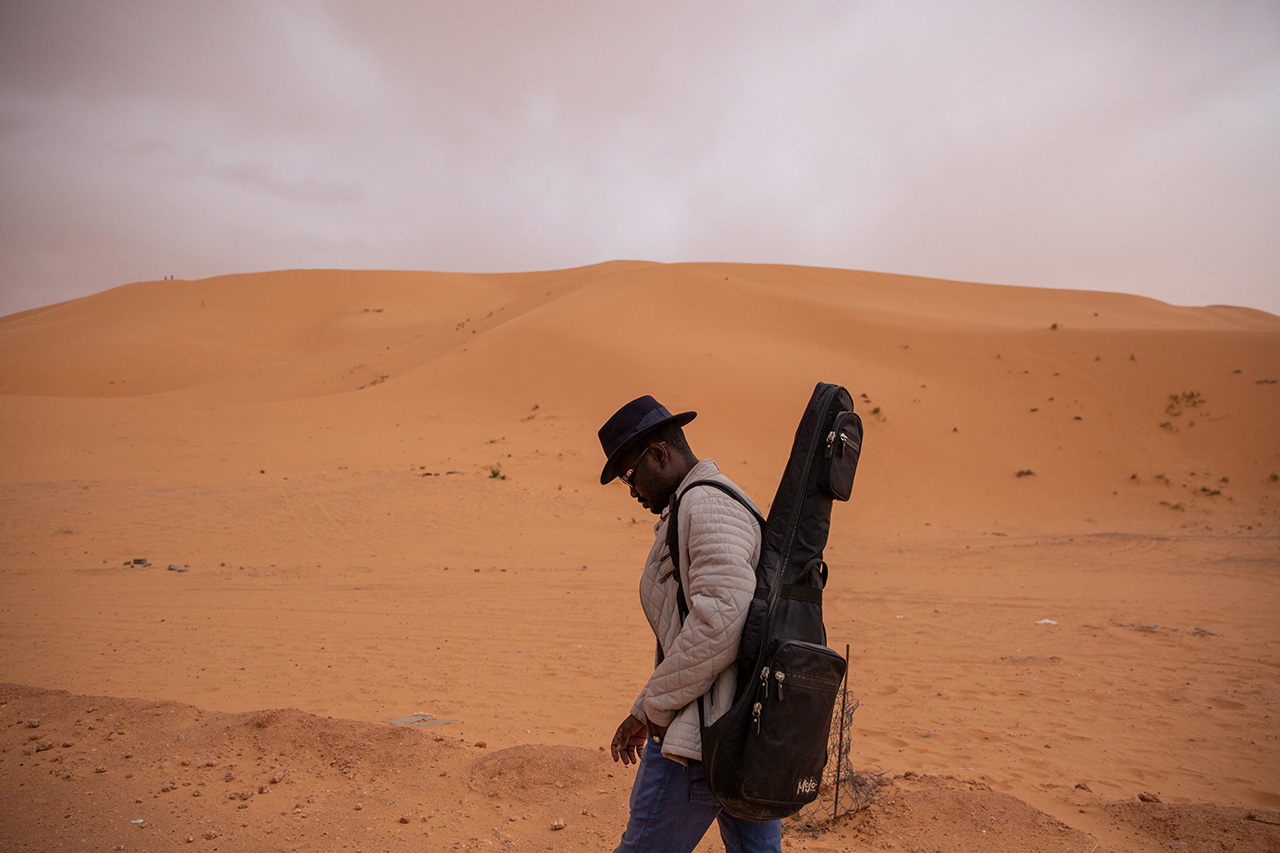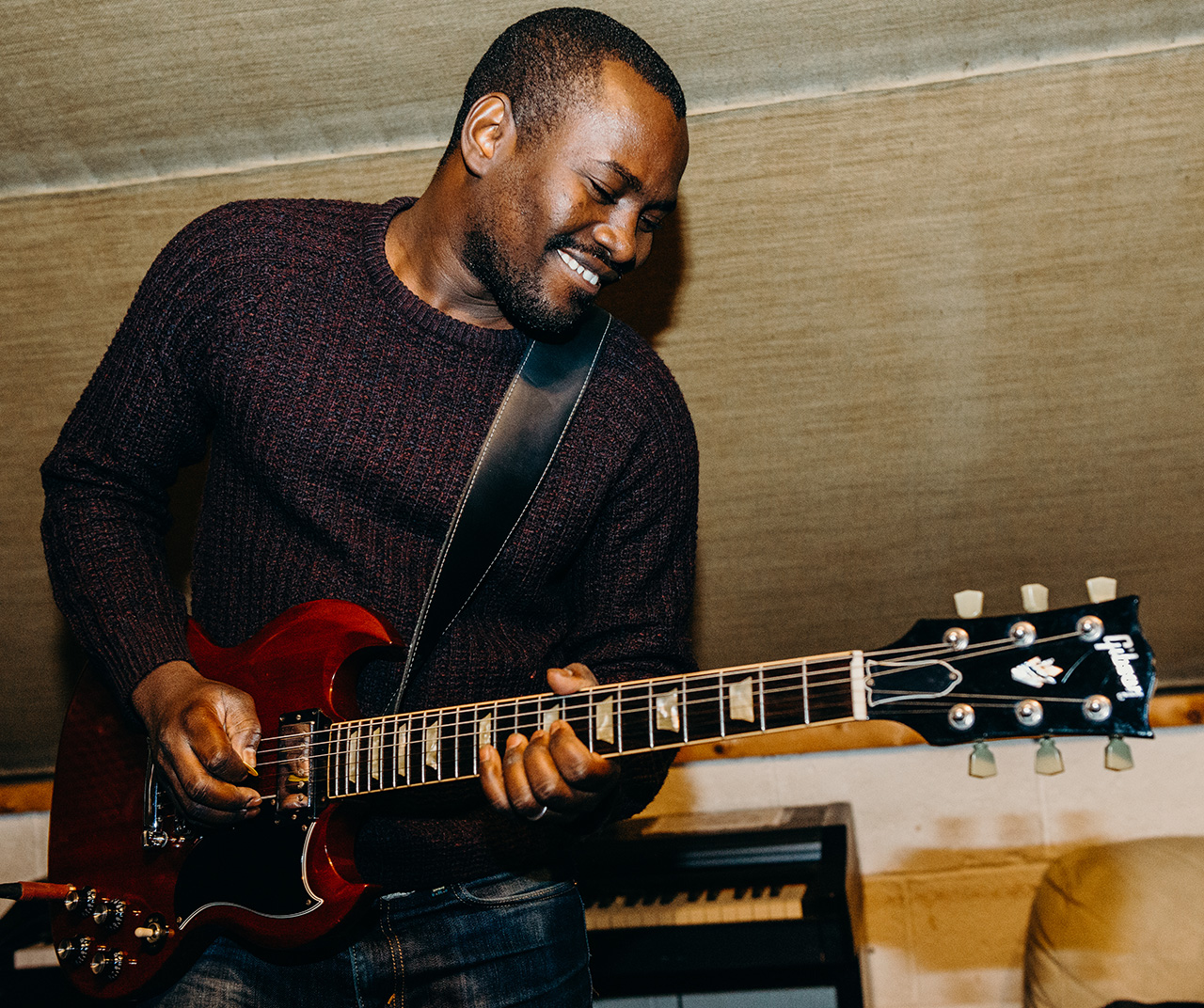When Songhoy Blues hit the international airwaves with Music In Exile in 2015, they quickly made a name for themselves – not only as a formidable new force in desert blues, but also as a powerful voice of resistance in a nation deeply affected by civil unrest.
Hailing from Diré, near Timbuktu in northern Mali, guitarist Garba Touré was among thousands forced to flee their homes in 2012, amid the rise of militant groups who imposed strict interpretations of Islamic law, deeming music to be – haram, a without.
He relocated to Mali’s capital, Bamako, where he teamed up with Aliou and Oumar Touré to form Songhoy Blues. Blending the musical traditions of their homeland with Western rock influences, they forged a supercharged sound and began using it to spread messages of hope and unity.
Garba says he quickly assembled all the tools a rock revolutionary needed to produce “a very strong sound on stage” – a Fender Stratocaster, a Gibson SG, a mix of Vox and Fender amps, and a pedalboard loaded with distortion, reverb, delay, chorus, overdrive and wah-wah.
“We’re an African band who make hard rock,” he explains. “If you listen to Malian music before Songhoy Blues, you’d never hear anyone do this. It’s like a little Foo Fighters or maybe a little Rolling Stones from Mali.”
His love of music was sparked early on by his father, a percussionist for Malian guitar legend Ali Farka Touré. “My dad taught me a lot about Jimi Hendrix,” Garba recalls. Soon he found Stevie Ray Vaughan – a “favorite forever” – as well as Eric Clapton and Jimmy Page. Then came John Mayer, Joe Satriani, Steve Vai, and Joe Bonamassa.
“I listened to hundreds and hundreds of guitarists,” he enthuses. “Blues, rock, country – it all excited me.” That included Malian trailblazers like Mama Sissoko and Baba Salah, alongside greats from Congo and Guinea including Diblo Dibala and Sékou ‘Bembeya’ Diabaté.
Along with his bombastic improvised soloing, Garba soon unlocked his signature style of “African rock, African roll” – but, on their latest album, LegacySonghoy Blues have taken a bold turn, shedding their electric instruments in pursuit of more traditional tones.

“We tried to be really simple this time,” he says. “No distortion, no overdrive and no drum kit.” The record features Malian musicians and represents a real roots celebration of local musicianship, via kora (harp), soku (one-string fiddle), kamale ngoni (8-string youth harp), flute, balafon (gourd-resonated xylophone) and earthy calabash percussion.
“Nothing is industrial; nothing is made by machine,” he says. “We make these instruments by hand. Each part is from the wood, giving us a really natural acoustic sound.”
Their departure into unplugged territory is more than just nostalgia – a decade of exile in the vibrant musical hub of Bamako has reshaped Songhoy Blues’ understanding of heritage. “You get more inspiration and more style if you listen to lots of things,” says Garba, emphasizing the band’s belief in intercultural exchange. “You make a new style.”
Across its 11 tracks, there are traces of takamba – a style of music and dance native to the Songhoy and Tuareg peoples – as well as Wassoulou music, Mande griot music and Senufo dance. Lyrics are sung in Songhai, the language of the Songhoy, and Bambara, the main language of southern Mali. New compositions like Store, Dagabi and Issa sit alongside with reworkings of regional classics such as Stretch and Gambary.

Garba’s guitar sound is coloured by evocative altered tunings inspired by traditional instruments like the ngoni, which is typically tuned pentatonically.
“I put the guitar in a chord,” he explains. “If you gave it to an American guitar player, they wouldn’t be able to play it! The first people to do that were guitarists like Ali Farka, who worked on the chord first. I can play exactly on the guitar what I play on ngoni.”
Ali Farka Touré’s most well-known altered tuning raises just the low E string by a minor third, from E to G, resulting in a G-A-D-G-B-E setup.
Open and ambiguous, the tuning broadly resembles a G6add9 chord and contains all the notes of the G major pentatonic scale – though not arranged in ascending order, as they would be on a ngoni.
If you just listened and you didn’t see me, you might think there’s a lot of instruments playing together
While preserving the guitar’s natural chordal and rhythmic flexibility, the altered sixth string is perfect for thumbing propulsive drones beneath fingerpicked melodies and modal riffs in G. “When we play these kinds of lines, the way we move our fingers is different,” Garba says, stressing that he relies on instinct, rather than academic know-how to navigate the fretboard.
“For us it’s very simple – but I meet a lot of people around the world when we travel and they find it very, very mystic.” He adds: “With just one guitar we make a lot of sounds,” demonstrating a pinching motion with his index finger and thumb: a technique for playing basslines and melodies simultaneously.

Double picking, open strings and rapid hammer-on and pull-off phrases also feature heavily in his lead style. “If you just listened and you didn’t see me, you might think there’s a lot of instruments playing together,” he says.
On Legacy he used Takamine and Yamaha steel-string acoustic guitars and recorded in a sonically dry studio setting, “with good acoustics, no reverb” – a fitting choice for an album that so vividly conjures the arid heat of the Sahara and the dusty streets of Bamako.
This summer, Songhoy Blues will return to touring in the UK and beyond, playing a 50:50 split of electric and acoustic material. “I want people to come and discover us in different way,” Garba explains. “The Songhoy Blues sound is traditional and it’s modern.”
GIPHY App Key not set. Please check settings